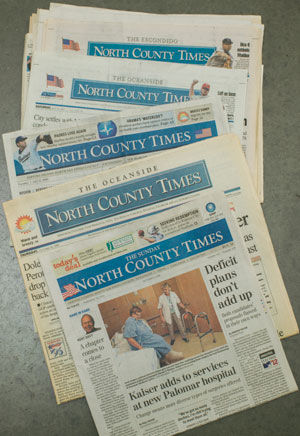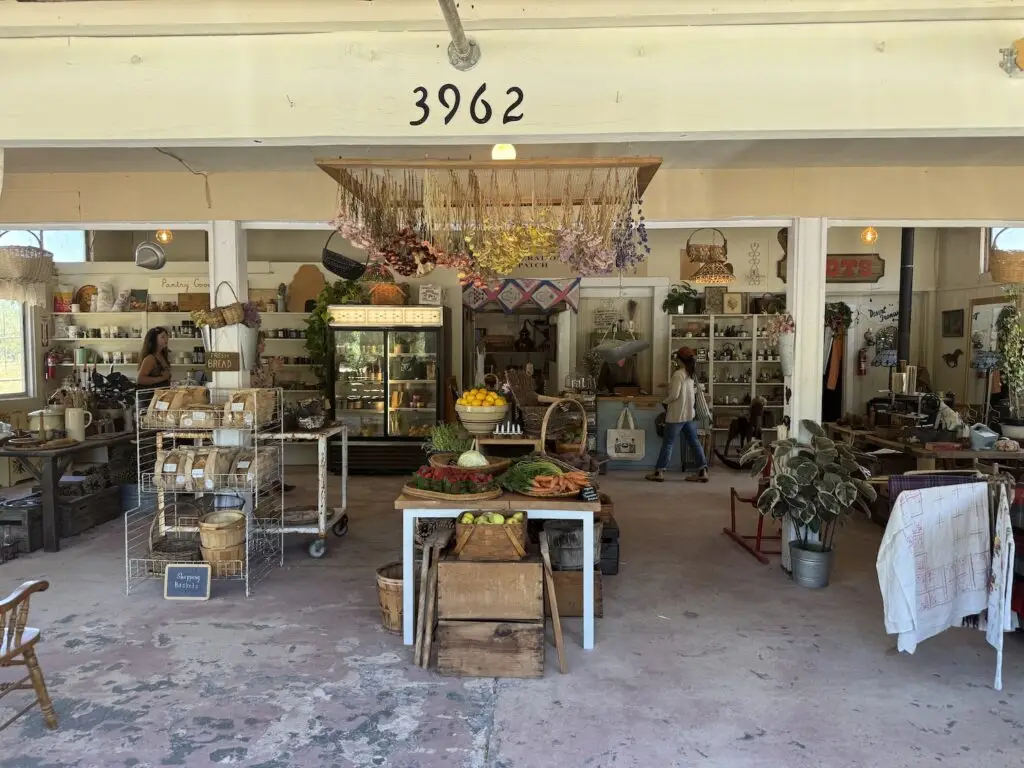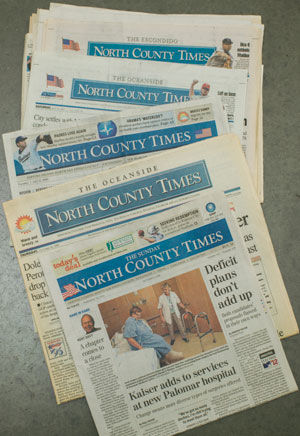1996 MORE ON THE MERGER
Peggy Chapman (Human Resources Director, 1995-2012): They [the staff] would ask questions what’s our vacation policy gong to be, we posted on a wall near my office all the questions people had and all the answers we came up with. Some of us had different benefits, we had to sort all of that out, what were the titles going to be, as things came up we dealt with them. Dick High used to say, it’s just us chickens to figure out. We basically got to build this newspaper from scratch and that was pretty cool.
Jim Trageser (Web editor, feature editor, 2003-2006, 2007-2012): I remember Working out of Oceanside to put out the Blade, and then running over to Escondido to teach them pagination. We were Apple’s first large installation on the powermacs. We had technicians from Cupertino every day, trying to get them working right. There were a days we almost didn’t have a T-A.
Jamie Lytle (Photographer, 1995-2012): When we merged, Dick High started giving us frickin’ raises which was great.
Laura Groch (Features Editor, Copy Editor 1995-2012): I remember the first Christmas bonuses, when we actually were getting Christmas bonuses. the way they handled it was that Rusty, who had not been my boss, gave me the bonus, instead of Rich Petersen. It went to the other editor to show this is all one family now.
Bill Wechter (Photographer, 1995-2012): In those early days, through that time period, the North County Times, at least the first several years, for photographers, there was always this battle for space int he paper. the philosophy was 8 or 9 stories, so there was a big battle for art. to get a 4 column picture was the biggest deal, this one is so good you gotta do this, you gotta do that. That was the early days. It was just a philosophy that Dick High had, you needed so many elements on section covers.
Trageser: I think Dick was right to bring Kent in from outside. That’s what allowed the North County Times to become its won animal different from the Blade and T-A.
MORE ON HARMONY GROVE:
Hayne Palmour IV (Photographer, 1995-2012): The Harmony Grove fire, started in Escondido roared into Carlsbad, terrible fire burned hundreds f homes. Every time one of those fires happened the news room kicked into gear. We really shined. What we did well was keep the community informed on what was happened. The energy level went up several notches each time these big fires happened, everybody knew what we had to do and went as long as we had to go to make it happen.
Kent Davy (Editor, 1995-2012): I remember Jaimie Lytle coming back and bringing back fantastic fire photos at the same time. He’d been on hot embers and the soles of his shoes had melted.
Rusty Harris (Managing Editor, 1995-2010): The fire was really bad for 3 days. The second night of the fire, I get this phone call, it’s Kent. He was actually traveling through California by that time by car, the first words out of his mouth were, “Do I still have an office to report to?”
I laughed and said, “Of course!” However I knew that he had rented a condo in La Costa. I said, “You might want to check to make sure your condo hasn’t burned, because that’s where most of the damage is.”
1997: SCOOP: COACH ROSS DEPARTS
Jay Paris (Sports writer, 1995-2012): [Chargers General Manager] Bobby Beathard at the time lived in Leucadia and I lived in Encinitas. We would often carpool to work together. We could use the carpool lane I-5 from Via de la Valle, we’d meet at Java Hut. We would sit in the car and talk, he would give me stuff I could use later. (He was also the absent minded professor, a few times I got left out at Chargers park because he’d leave without me).
That relationship centered around both of us being North County guys — both of us liked to play in the water and play in the waves, and that was the basis of getting the scoop later on, reading Bobby and knowing his body language, knowing what a bad liar he was. He kind of tipped his hand without doing it.
He didn’t say it [that he was firing Ross] outright, but you could tell he was hiding something. He wouldn’t say anything, you’d read it through the sign language. I called one of the assistants at the time. I used the old trick, ‘I’m going to write this tomorrow, cough if I’m going to look like an jerk.’ That was big.
1999-2000 Y2K
Peggy Chapman (Human Resources Director, 1995-2012): We had planned to get a paper out, regardless of whether we had power. We had bodies on standby, we had a plan to put a generator in and run a copier of printed pages. [Publisher[ Dick asked all the managers to be at work on New Years Eve, just in case there was a disaster. One employee, at 9 p.m., when New York didn’t have a disaster was so disappointed. 10 came, no disaster. 11 came, no disaster. Midnight came, our lights stayed on.
Everyone left and I was stuck with all this food to clean. I was like, “Happy New Year.”
YEAR UNCERTAIN: (1999 or 2000, most likely) MAN LEAPING FROM A BRIDGE PHOTO
Kent Davy (Editor, 1995-2012)We were at a performance, a fund raising performance, and Judy Collins was performing. I got a call from the newsroom, “We need you to come over here.”
A distraught man had climbed up on an overpass bridge there in Escondido and stayed up there for a number of hours and had traffic tied up in all directions for hours. We had a photographer, I don’t remember who the photographer was, somebody was on the scene and had snapped a photograph of a man as he jumped and caught him in midair. I got called over to talk to the Saturday or Sunday crew about what to do. After a lot of handwringing over if this is news, I eventually gave the OK to run that as the lead shot on the front page. Dick told me, “I wouldn’t do that but you make the decision you need to.”
We ran it, and the community outrage was phenomenal. Hundreds and hundreds of angry phone calls, cancelations. I spent a lot of time trying to absorb that. Ultimately, while running that photograph in certain metropolitan papers would be OK, running it in a community newspaper exceeded the bounds of propriety and taste and did nothing but offend a great many people. People would call and say, “Do you realize this is the only thing my daughter saw when she picked up the paper on Sunday morning?” The man’s children came from Virginia a week or two later and met with me. The anger and animosity towards me for having made that decision always stuck with me.
2000-2001 SCOOP: CALIFORNIA POWER CRISIS
Kent Dave (Editor, 1995-2012): [Business reporter, later managing editor] Dan McSwain’s reporting on the electric crisis in 2000 was arguably nation leading. We were clearly the first paper in California to describe what was going on in the whole electricity debacle.
There was an economic conference, some training session, up in the Bay Area, and I told Dan, who was then a business reporter, that I’d like him to go. He talked to some professors how said there is a huge story on the horizon and this whole deregulation process that’s going through. Dan was prepared for that and turned into probably the most knowledgable electricity writer in the entire state. We led the state over and over again breaking stories, like the description of the various trading stories Enron had, I think Dan had that 3 or 4 months before anyone else did. My recollection is that some of the key players in the industry in fact ultimately did give us credit, said to their peers there is a paper that has really covered this thing and done a great job.
Dick High (Publisher, 1995-2007): The energy crisis in California started in San Diego county a year earlier. It started here. Dan had, he worked full time on it for about two years. He had it so well covered, where the money was going who’s making it,who’s getting fooled, it was just superb coverage and it became a state story the next year, and to my great chagrin the LA Times won a Pulitzer for it, and Dan should have had it. I know the [California Public Utilities Commission] was reading us every day.
2001 – 2004 LIBRARY CAT
Randy Dotinga (Reporter, 1995-1999):In the late 1990s, a cat lived at the Escondido library. “Library Cat” was a local celebrity in Escondido and the paper wrote about him all the time.
One day, a little girl with her little dog are walking in front of the library, right by the sliding glass doors, and the dog sees library cat over by the checkout counter. Library Cat sees the dog, and the dog sees Library Cat.
The cat attacks the crap of the dog.
The cat knows how to use the sliding glass doors – the cat leaps off the counter, waits for the doors to open, and attacks the dog. The dog starts screaming, the girl starts screaming. There’s a commotion, and the dog is injured.
The library has to figure out what to do with the cat. Do you get rid of the cat? The library has meetings, and they decide to keep the cat. Library Cat remains in the library.
Some time passes.
A courts reporter named Rik Espinosa starts working at the North County Times. And Rik has a mental health assistance dog, and the dog’s job is to put a ball in Rik’s lap when he was going to have a panic attack, to warn Rik of pending panic attack. The dog goes with him to the courthouse, the dog goes with him on his duties covering things.
So one day, Rik Espinosa needs to do some research. Where do you go if you need do some research? The library. So Rik goes to the library with the assistance dog. He goes to the checkout counter – and Library Cat sees Rik and the dog. And Rik and the dog see Library Cat. And Library Cat attacks the assistance dog. And Rik Espinosa promptly has a panic attack. Rik hurts his back trying to protect the dog and the dog is injured, too. So Rik goes to his doctor and the dog goes to the vet.
Let’s say you’re Rik Espinosa, you hurt your back, and your dog has been attacked by Library Cat. What would you do?
You would sue the library for $1.5 million plus the cost of the vet and dog visits. This becomes a big news story, and it’s covered all over the place, including the North County Times.
Some time passes and Library Cat remains in the library. Then one day comes a woman decides to take the dog for a walk. They decide to go to the library. They’re outside the library, they look in the window. She says something like this: “Let’s see if we can see the famous Library Cat. There’s Library Cat. Do you see Library Cat, Fluffy? Fluffy!!”
Library cat attacks Fluffie.
At this point Library Cat’s day are numbered. Library Cat is sent out to the country to live out his days away from the library and away from Rik Espinosa and away from little dogs. The city eventually wins the lawsuit, the judge throws it out.
Rik goes away, Library Cat goes away, the North County Times goes away. At least one of those three was a big pain in the big pain in the ass.
2003 MORE ON IRAQ
Peggy Chapman (Human Resources Director, 1995-2012): It was super scary, there were so many unknowns, we didn’t know, would they have health coverage, would they have workers comp, they needed immunizations. I remember watching Hayne sign a will, because they didn’t have one.
Cyndy Sullivan (Photographer, Photo editor, 1995-2007): When they went off on that second trip, it didn’t seem like it was going to be quite as life threatening. That turned into full on guerrilla war. It wasn’t going to be hearts and minds any more, there were a couple of times during that coverage that we though we were going to lose them. I remember speaking to Hayne on the phone when he was in Fallujah, I could hear gunfire in the background and then the phone went dead, I remember being panic stricken, but we didn’t have a plan in place. We had feet on the ground in Iraq, but we needed feet on the ground in San Diego – we needed to make sure their safety was secure. I remember calling a friend of Haynes at CNN, if she might be abel to help us with an extraction plan if we needed it . That’s how little we knew about that.
Hayne Palmour IV (Photographer, 1995 – 2012): [Before leaving for Iraq] There was a lot of stress and a lot of fear. It was an extremely stressful couple of weeks. You’re being told by everybody that Saddam has weapons of mass destruction, chemical and biological, trying to picture what you’re going to be going through embedded with Marines in the desert. Every imagination I came up with was so far from reality when it happened.
I had friends that were crying, “Why are you doing this, you could get hurt.” Then I had journalist friends, “Wow, what a great opportunity.”
I remember when the marines were fighting to get into Baghdad, the last big battle. We were watching artillery rounds going over our heads, and at some points I could hear Marines yelling. I could hear the artillery explosions, shooting, sometimes even yelling. We were far enough away from it that we were hunkering down. So there I am, we’re just covered in dirt. I got the computer out, the satellite, each time we could get on, we’d barely have enough power, I’d check my email real quick before the the whole thing died. There was this email from Cyndy Sullivan, “the wife of Corporal whatever just had a baby, if you find him, here’s a picture of baby.” And I opened the picture of the baby. The captain is right next to me, “You got a corporal so-and-so?” He said, “Yeah.”
They went and got him.
I said, “You corporal so-and-so? Your wife just had a baby. Here’s your baby.”
He looked at it and stared at it for 30 seconds, he said, “Thank you sir.” and walked back to his position. I thought, that was so now. Has that ever happened before in any other war? The guy is on the line, a battle is raging not far away, and some guy with a laptop: “Here’s your baby.”
2006: SCOOP: QUEEN LATIFAH INTERVIEW
Jim Trageser (Web editor, feature editor, 2003-2006, 2007-2012): Queen Latifah and said they’d only do one interview in the area and they did it with us. I got backstage passes and took my 15-year-old daughter and she didn’t hate me for a whole week.
2006 RIOTS AT EL CAMINO HIGH SCHOOL
Jamie Lytle (Photographer, 1995-2012): At El Camino high school, there was kind of like a race riot going on. A tension between the blacks and the hispanics, there was a full-on lockdown. We ran there and Hayne was already there, all the Oceanside cops were in there, they’re in their riot gear and marching in line, and I get there all of a sudden these teachers started attacking me — grabbing and pushing me – and the cops were like, “Don’t touch him.”
I go into the principal’s office to complain, and the principle has all the journalists in the room when all the stuff was happening. I was like, “Look the teachers are physically attacking me for taking pictures at this thing.” I walked in and start screaming. That was a crazy one, the El Camino High riots.
I was a little shaken up. I decide those teachers aren’t going to get away with attacking me like that, I decided to get a lawyer and teach those teachers. I asked the frickin’ reporters who cover the courts, “Who’s the best lawyer you know?”
The next day I hear we’re suing the Oceanside School District for $1.2 million. The lawyers took it and ran with it. I was like, I don’t want this to be news. That was a crazy thing. The attorneys wanted a bunch of money and Dick High wasn’t going to help with that. They dropped the suit, they wanted money.
As soon as they heard, I had school board members calling me and apologizing, so it got their attention.
2006 KENT DAVY’S WIFE JOEL WAS DIAGNOSED WITH CANCER
Kent Davy (Editor, 1996-2012): She was diagnosed in the summer of 2006 and at first we thought the diagnosis was lymphoma, and treatable. Like 2 weeks later or so it was confirmed as lung cancer. That diagnosis was like I had been hit with a shovel in the face. Dick High, who I think is among the most generous and compassionate people I have ever known, gave me leave to take care of Joel, take as much times you need. Joel lived from that August to the following July, died in July of 2007. Dick granted me basically leave to spend as much time as I need to taking care of her, taking her back and forth in the doctor, if we had no one here at the house, to stay with her and be her caregiver. I would say through a large part of that year she was sick, I was pretty scarce in the newsroom. A whole bunch of really competent people stayed and took care of things and put out good newspapers while I was gone.
2001 JOHN VAN DOORN AND THE FLYING CAKE
Kent Davy (Editor, 1996-2012): John Van Doorn, John came from, was a big city newspaper man, very storied career Ernie Pyle winner worked form New York Times, news day, wanted me to hire him as writing coach, eventually as after a bunch of expensive lunches, if you want to come to work, I’ll hire you as a business writer. Eventually moves to being a senior editor and being a columnist.
Bradley Fikes (Reporter, 1997-2000, 2001-2012): John Van Doorn was business editor then. He was just like the epitome of old school journalist — very crusty on the outside, very caring underneath.
Gary Warth (Reporter, 1995-2012): The wrath of John was as an editor. My first experience with him was this guy who was so tough on people, to the point, I could see people reading (his comments) and breaking down and crying and becoming waiters and waitresses, “Is English even the writer’s first language,” might be something he would write in the comments.
Davy: He used to love being a key player in the birthday celebrations in the newsroom and carry the cakes in.
Laura Groch (Features Editor, Copy Editor, 1995-2012): Steve Whitmore, he was I think the Escondido city editor at the time, it was his birthday. Periodically we’d go through this thing of celebrating birthdays all the time, and the cake came in the other side of the room. Van Doorn took it upon himself while everyone was singing.
Davy: He’s got this great big cake with candles, someone yells, “Don’t drop it,” and John stumbles and the cake goes into the air.
Groch: That cake went flying through the air and landed on the floor, everyone was like, “Did he throw that cake at him?” Everybody was stunned for a second.
Warth: Any time someone had a birthday and there was a cake, it was his duty to carry it. John ever after had cake carrying duties.
2007 MORE ON WILDFIRES
Hayne Palmour IV (Photographer, 1995 – 2012): The ’07 fire, that was really intense. Ireland and I, he and I were out there east of Ramona. We got caught, I’m thinking way more safety now, I’m thinking and marking open areas are to run to safety, this fire seemed particularly fast, and the only way out was that two-lane highway. So it roared past us, we were in a field, literally the grass burned right up to my car.
He took video that came out to be the most intense video. He shot video as we were trying to drive. We had to make our way back to Ramona to get to cell range to make deadline, so we had to go. It was very intense, as you’re driving this road, everything’s glowing or burning, you just don’t know what the next turn takes you into as far as the fire, and it was scary. And it was brand new Prius I had, the last thing I wanted to do was melt the paint or screw it up in some way. I had surf racks on it. Always in fires, trees fall or power lines fall over the road. We saw low hanging power lines and the surf rack grabbed it, and ripped the surf wrack for it, gouged a scratch in it. I’m out looking for my brand new $300 surf rack.
Monica Hodes (Copy Editor, Night Editor, 2002-2012): I have a vision on the nights of the fires, printing out all the photos and sitting in my office chair with like 16 photos spread out on the floor in front of me having Kent (Davy) and Dan (McSwain) help me pick out which photos go where, labeling them, throwing them at the paginator, this one goes there, that one goes there. Tons of photos on the floor, and we’d lay out the pages on the floor, and the progression of how the paper was going to look. We had 25 pages on the wall of proofs of the paper.
2006-2012 WEATHER PAGE ANTICS
Amanda Selvidio (Wire editor, assistant editor, 2006-2012):
When I started working there as a copy editor in April 2006, we had to manually input local temperatures for the weather page every day. It seemed like it took forever, but it was a known thing that readers take the weather page very seriously. We even had designated people call in to report the day’s temp and next day’s forecast for a few select cities or towns, such as Valley Center.
As the years went on, the paper got smaller and we were forced to move the weather page to A2. We had to fit a column, lottery numbers and Today in History on the same page, so this meant we had to cut the number
of temperatures and forecasts for cities in the nation and world. We might as well have had a weather committee because it took weeks, no probably months, to get it down just right, and there were a bunch of people involved at one point, including Kent (Davy), Dan (McSwain), me and Barbara (Trageser), who were wire editors, and Edwin (who built the page almost everyday). Just when we thought we had all the most important and requested cities, I’d get a call from a reader asking us to include yet another obscure location. Finally we got it, but it really felt like a never-ending cycle which probably would have continued for years to come.
2008 SPRINTER OPENS
Zach Fox (Reporter, 2007-2009): The first day that it opened — it might not have been the first day, night not have been the first day, might have been some tests – somebody lay on the tracks in a place to kill himself and I guess misaligned and had his legs chopped off. Colleen (Mensching) was reporting on it and trying to get information on this victim, calling hospitals.
This PR guy was always giving us flack, he was like, “I don’t know who you’re talking about, give me a name,” and Colleen yells back, “He’s the one who just came in with no legs!”
2010 BOMB HOUSE
Chris Nichols (Reporter, 2008-2012): That was one I helped out with quite a bit. I think maybe the most vivid memory when it come to that story was staying overnight at the home of a family who lived right on the edge of an evacuation zone that had been set up the night before the actual burning of the bomb house. Hayne Palmour and I convinced the family to let us stay there so that we could witness and have a birds eye view of the burning early the next morning when we would have been shut out from entering the neighborhood by that time. Our only choice was to find someone who let us camp out in their living room and on their patio. We had a great perspective of the burning of that infamous house. Hayne found this particular family and just used his charm and persuasion. They were a large family that seemed more than interested in the story. They were very gracious and fed us and kept us entertained and let us use their home to cover that story.
2011 BAT IN THE NEWSROOM
Monica Hodes (Copy Editor, Night Editor, 2002-2012): One night one of the reporters in the corner started screaming and there was a bat flying around in the newsroom that night. It had gotten in through the back door and hallway that people used to take a smoke break. we were trying to capture a bat under this trash can, added to the fun chaos every night. I believe it was Deborah Brennan was the first to spot the bat. That’s a little wildlife action.

Web Exclusive: More on the North County Times


















